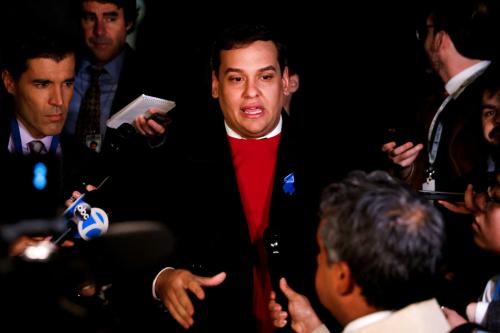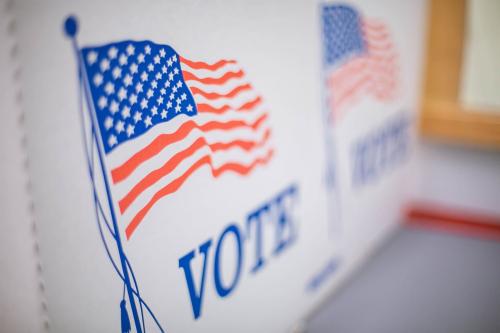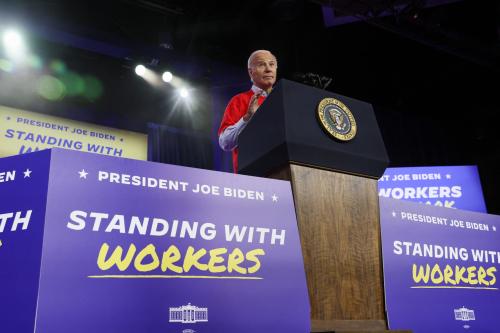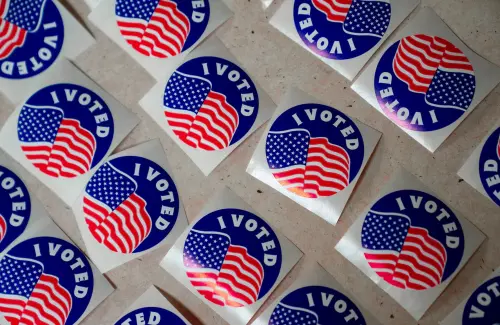This piece is part of “Polling young voters,” a series exploring some of the reasons young voters lack enthusiasm for voting in 2024 through polling analysis.
Remember the “Red Wave”? It referred to the big gains Republicans were supposed to make in the 2022 elections that did not materialize. The Red Wave talk was motivated by many things, but one of them was panic over what was happening to President Biden’s ratings among younger voters.
Consider this Newsweek headline from April 2022: “Younger Voters Are Turning on Biden More Than Any Other Age Group.” In late June, Charlotte Alter reported on the same trend in Time magazine but with an interesting — and, it turned out, prophetic — twist. The headline on her piece: “Young Voters are Down on Biden. That Doesn’t Mean They’ll Bail on Democrats in the Midterms.”
Indeed, they didn’t. An analysis of the 2022 exit polls by the Center for Information and Research on Civic Learning and Engagement (CIRCLE) at Tufts University found that in 2022 U.S. Senate races, Democrats got 70% of the youth vote or more in Arizona, New Hampshire, and Pennsylvania and 60% or more in Georgia, Nevada, Ohio, and Wisconsin.
Commenting on this year’s off-year elections, Semafor’s Jordan Weissman offered a pithy take on X underscoring the same point: “At the moment, young people hate the Democratic party, except on election day.”
None of this means that Biden and the Democrats should ignore recent polls suggesting trouble for Biden among young voters in matchups against Donald Trump. Yes, they should take them with a grain of salt. But they should also pay attention. Ignoring early warnings is a bad idea in all aspects of life, especially elections.
First, the salt. Daniel Cox, director of the Survey Center on American Life and a senior fellow in polling and public opinion at the American Enterprise Institute, pointed to basic reasons for a certain skepticism toward presidential polls this far out from Election Day, especially among young voters “who mostly do not pay attention to politics at this early stage.” Many of these surveys, moreover, have relatively small samples of young Americans. Cox observed that some of the surveys might reflect the likelihood that “young conservatives were more committed to Trump than young liberals were to Biden.”
The difficulty of gauging exactly where young voters stand was underscored in the fall 2023 Harvard Youth Poll conducted by the Institute of Politics at the Harvard Kennedy School. It is one of the best ongoing surveys of young voters. Conducted between late October and early November, it found that Biden enjoyed a 10-point lead among all adults under 30, a 15-point lead among young people who said they were registered to vote, and a 24-point lead among the most likely voters. This advantage matched Biden’s lead over Trump in the 2020 exit polls. Your view of where Biden stands might depend on which of these numbers you focus on.
Cox’s conclusion is that some of the recent findings are not “apocalyptic” but should “alarm” the Biden campaign, nonetheless. That’s the right attitude: The Biden campaign should not panic, but it should be worried — and act on that worry.
I agree with my colleague Bill Galston that economic concerns are a major part of this story, and the Biden campaign needs to deal especially with prices to win back support both among the young and in the broader electorate. Its economic messaging needs a lot of improvement. The administration has taken steps lately to highlight what it is doing about prices and used the Thanksgiving holiday to show that some prices are coming down — for example, the price-per-pound for turkey and the lower costs of flying to grandma’s house, or anywhere else. But the Biden campaign now seems to recognize that much more needs to be done.
More generally, young people face challenges of their own, particularly in the housing market. Yet, government spends much more helping older folks than young Americans.
That’s why I have been pushing for some time for what we’ll update as the Next Generation Act of 2023. It could include job training for a rapidly transforming economy; new stabs at student loan forgiveness and wider access to higher education, including community college; comprehensive childcare and early education; and seed money, similar to provisions of the GI Bill, for young people to buy homes and start their own businesses. This could be linked to a much larger national service program.
Young voters think politicians pay a lot more attention to other people than to them. They’re not wrong about this — and the more young voters increase their turnout, the easier it will be to battle this problem. But politicians need to give them reasons to vote. Biden is in a position to do just that. These poll numbers should give him a nudge — perhaps even a shove.
The Brookings Institution is committed to quality, independence, and impact.
We are supported by a diverse array of funders. In line with our values and policies, each Brookings publication represents the sole views of its author(s).








Commentary
For Biden, youth vote polling is a warning, not the apocalypse
December 6, 2023